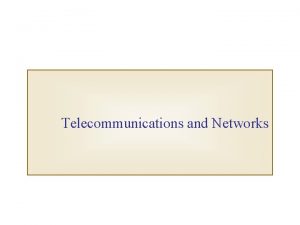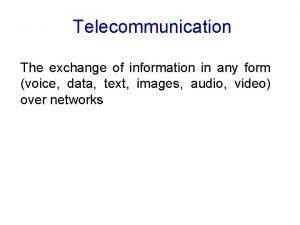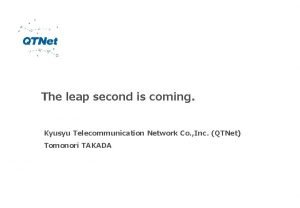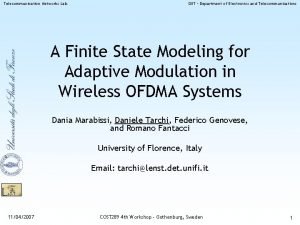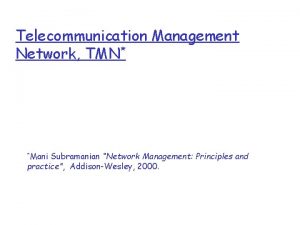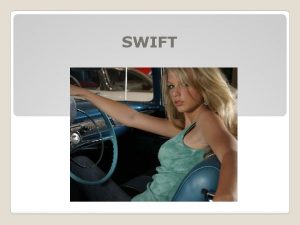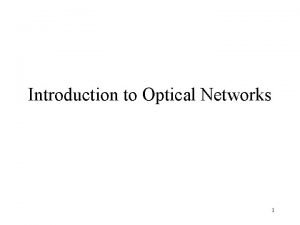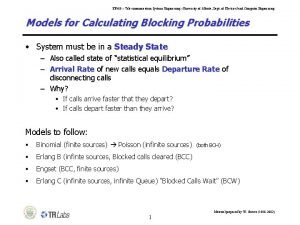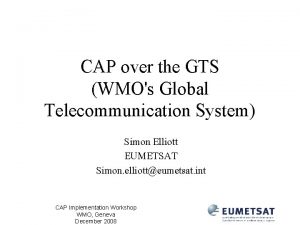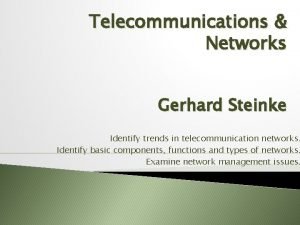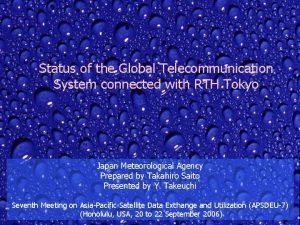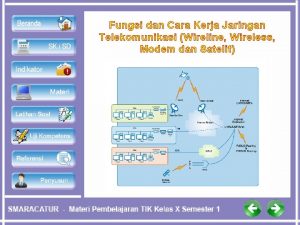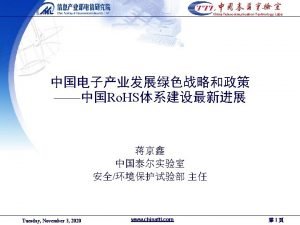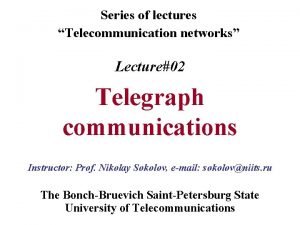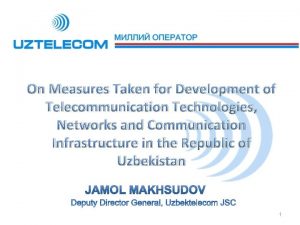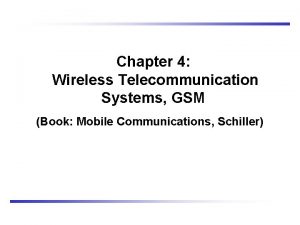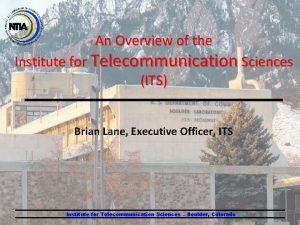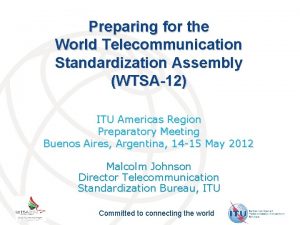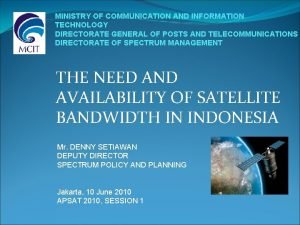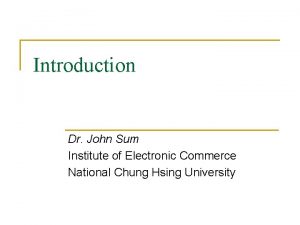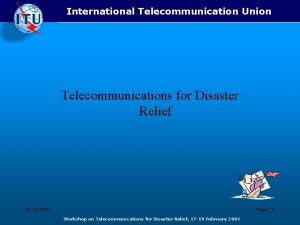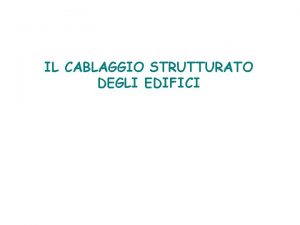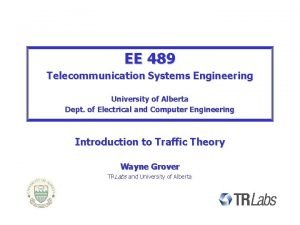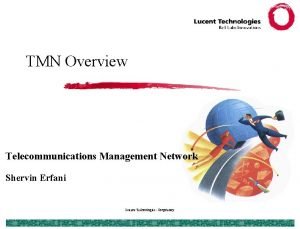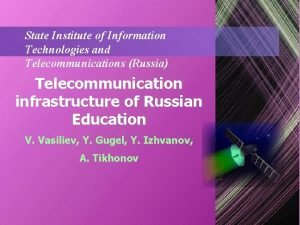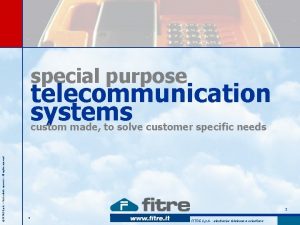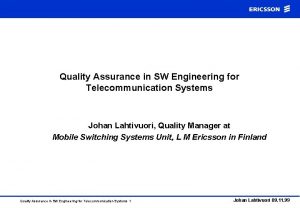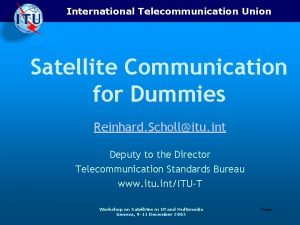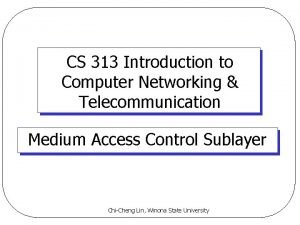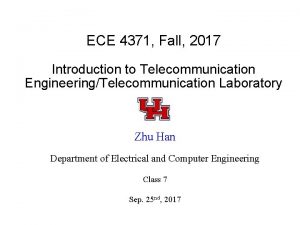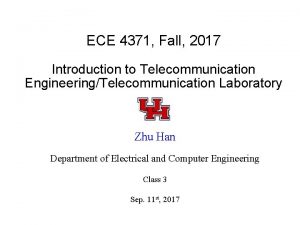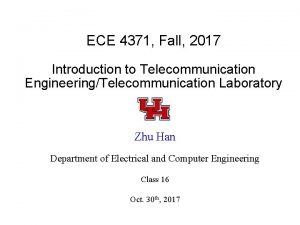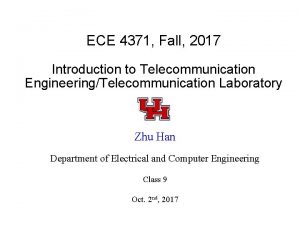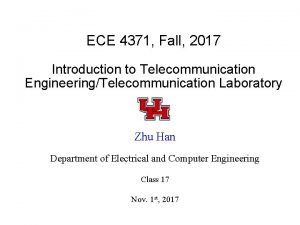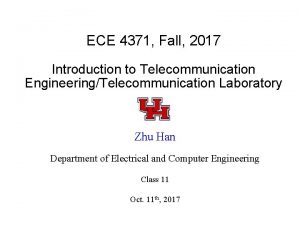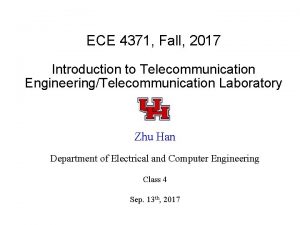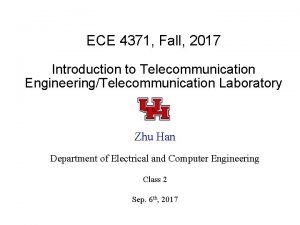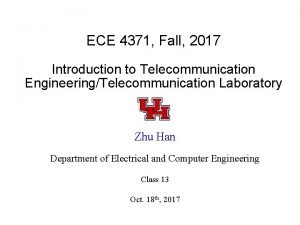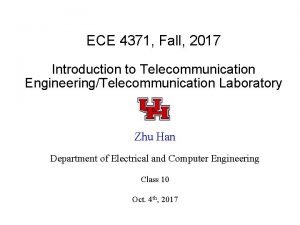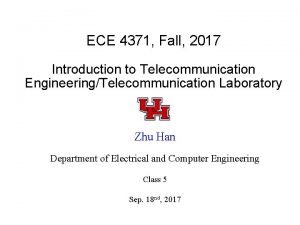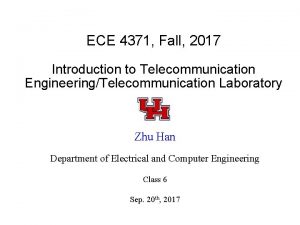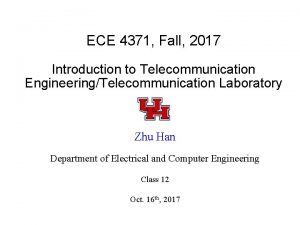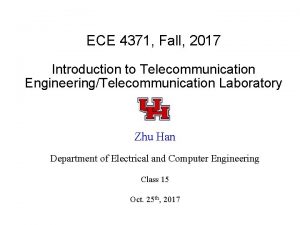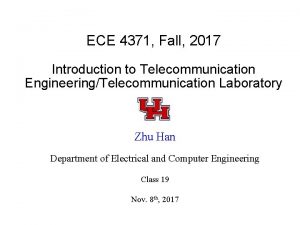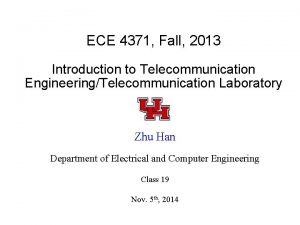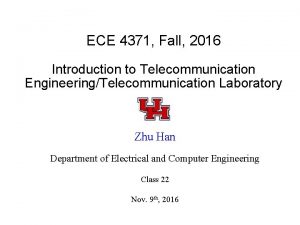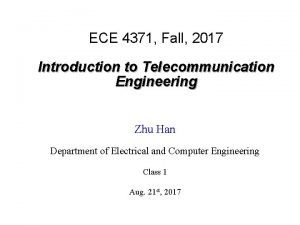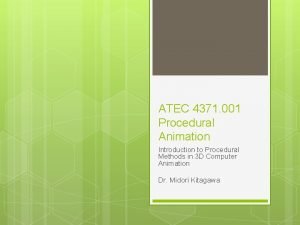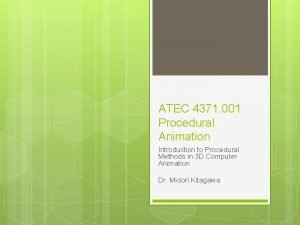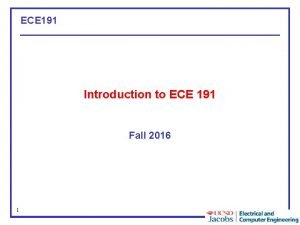ECE 4371 Fall 2017 Introduction to Telecommunication EngineeringTelecommunication






































- Slides: 38

ECE 4371, Fall, 2017 Introduction to Telecommunication Engineering/Telecommunication Laboratory Zhu Han Department of Electrical and Computer Engineering Class 18 Nov. 6 th, 2017

Outline l CDMA(code division multiple access) – – – Introduction FHSS(frequency hopping spread spectrum) DSSS(direct sequence spread spectrum) Application Road map

Spread Spectrum Modulation Techniques l Definition: – The bandwidth of the transmitted signal is much greater than the bandwidth of the original message. – The bandwidth of the transmitted signal is determined by the message to be transmitted and by an additional signal known as the Spreading Code. Two main Spread Spectrum modulation techniques l – Frequency Hopping Spread Spectrum (FHSS) – Direct Sequence Spread Spectrum (DSSS) l Two major advantages: – Low power density – Redundancy

Spread Spectrum Transmission l A spread-spectrum transmission offers three main advantages over a fixed-frequency transmission: – Spread-spectrum signals are highly resistant to noise and interference. u The process of re-collecting a spread signal spreads out noise and interference, causing them to recede into the background. – Spread-spectrum signals are difficult to intercept. – Spread-spectrum transmissions can share a frequency band with many types of conventional transmissions with minimal interference.

Spread Spectrum Transmission – Spread-spectrum signals are difficult to intercept. u u A spread-spectrum signal may simply appear as an increase in the background noise to a narrowband receiver. An eavesdropper may have difficulty intercepting a transmission in real time if the pseudorandom sequence is not known. – Spread-spectrum transmissions can share a frequency band with many types of conventional transmissions with minimal interference. u u The spread-spectrum signals add minimal noise to the narrow-frequency communications, and vice versa. Therefore, bandwidth can be utilized more efficiently.

Outline l CDMA(code division multiple access) – – – Introduction FHSS(frequency hopping spread spectrum) DSSS(direct sequence spread spectrum) Application Road map Hedy Lamarr

Frequency Hopping Spread Spectrum l Definition – A method of transmitting radio signals by rapidly switching a carrier among many frequency channels, using a pseudorandom sequence known to both transmitter and receiver. l Military use – Highly resistant to deliberate jamming – Limited protection u l The JTIDS/MIDS family, HAVE QUICK and SINCGARS Civilian use – In the unregulated 2. 4 GHz band

Frequency Hopping Pattern l A transmitter "hops" between available frequencies according to a specified algorithm. l The transmitter operates in synchronization with a receiver, which remains tuned to the same center frequency as the transmitter.

System Structure

Pseudo Random Sequence Generator l Random sequence – – l Randomness and noise properties Provide signal privacy Two properties – Randomness and unpredictability. l Pure randomness is hard to achieve. – Pseudorandomness, the sequences produced are long and there is no way of predicting the next number from the sequence.

Pseudo Random Sequence Generator l Linear Feedback Shift Registers(LFSR). – LFSR are implemented as a circuit consisting of XOR gates and shift register. – The register is a string of 1 -bit storage devices. l The m+1 th bit is output as the result of an operation on the previous m bits in the register. l By using a long enough sequence of bits, the sequence may appear to be random, even though it is actually a long cycle. ECE 4371 Fall 2008

FHSS Resistance of Jamming l Narrow band jamming l FHSS under broadband jamming l FHSS under partial band jamming – Jamming on one frequency affects only a few bits

Multiple User Access l Only one user with a large bandwidth is too wasteful. l Allows multiple user to be admitted over the same frequency. – This creates the possibility of system data rates that are higher than the Shannon limit for a single channel. l Each transmitter is assigned a unique code which allows multiple users to be multiplexed over the same physical channel.

Multiple User Access l Well designed PN sequence can prevent user collision. l In practice, collision cannot be avoided – Lack of a common synchronization clock – More than L active users access

Outline l CDMA(code division multiple access) – – – Introduction FHSS(frequency hopping spread spectrum) DSSS(direct sequence spread spectrum) Application Road map

Compare with FHSS l FHSS adopts noncoherent detection (FSK) l DSSS adopts coherent detection (QAM, PSK, PAM)

Direct Sequence Spread Spectrum l Modulates with a continuous string of pseudo-noise code symbols called "chips", each of which has a much shorter duration than an information bit. l Spreading code spreads signal across wider frequency band – In proportion to number of bits used – 10 bit spreading code spreads signal across 10 times bandwidth of 1 bit code l Spreads the bandwidth of the data uniformly for the same transmitted power.

Spreading & Despreading l Spreading – Source signal is multiplied by a PN signal l Processing Gain: l Despreading – Spread signal is multiplied by the spreading code l Polar {± 1} signal representation

Direct Sequence Spread Spectrum l One method: – – Combine input with spreading code using XOR Input bit 1 inverts spreading code bit Input zero bit doesn’t alter spreading code bit Data rate equal to original spreading code

Multiple User Access l Unique code to differentiate all users l Sequence used for spreading have low cross-correlations l Allow many users to occupy all the frequency/bandwidth allocations at that same time

Narrowband Interference Suppression Transmitt er Receiver

Wideband Interference Suppression Transmitt er Receiver

Outline l CDMA(code division multiple access) – – – Introduction FHSS(frequency hopping spread spectrum) DSSS(direct sequence spread spectrum) Application Road map

Application l FHSS – Bluetooth – frequency-hopping code division multiple access (FH-CDMA) l DSSS – CDMA – GPS – WLAN

Bluetooth l Operates in the globally unlicensed (but not unregulated) Industrial, Scientific and Medical (ISM) 2. 4 GHz short-range radio frequency band.

CDMA Rake Receiver

Comparison

GPS l Why spread spectrum in GPS ? – Signal from satellite can be kept from unauthorized use. – Inherent processing gain of spread spectrum allows reasonable power levels to be user. – Each satellite can use the same frequency band, yet no mutual interference.

WLAN l Why spread spectrum in WLAN ? – Operates in the range of 2. 4 GHz short-range radio frequency band. – Interference resistance from other wireless device

Outline l CDMA(code division multiple access) – – – Introduction FHSS(frequency hopping spread spectrum) DSSS(direct sequence spread spectrum) Application Road map

Cellular Telephony Evolution 1 G 2 G 2. 5 G 3 G 3. 9 G 4 G Analog voice telephony Digital voice telephony (9. 6 kbps-14. 4 kbps) Digital voice telephony data connectivity Built-in self organizing mechanisms broadband data connectivity IP based protocol for voice and data No data connectivity CDMA, TDMA Example: AMPS 1981 Example: GSM, IS-54, IS-95 A, cdma. One 1992 ECE 4371 Fall 2008 Example: GPRS, IS 958, IS-136, (E)-GPRS 1999 Example: WCDMA, CDMA 2000 TD-SCDMA 2001 Mobile broadband data connectivity Example: LTE 2007 Interference mitigation and coexistence Example: LTEAdvanced 2011

2 G: IS-95 A (1995) l Known as CDMAOne l Chip rate at 1. 25 Mbps l Convolutional codes, Viterbi Decoding Downlink (Base station to mobile): – Walsh code 64 -bit for channel separation – M-sequence 215 for cell separation l l Standard IS-95, ANSI J-STD-008 Multiple Access CDMA Uplink Frequency 869 -894 MHz Downlink Frequency 824 -849 MHz Channel Separation 1. 25 MHz Modulation Scheme BPSK/QPSK Number of Channel 64 Channel Bit Rate 1. 25 Mbps (chip rate) Uplink (Mobile to base station): – M-sequence 241 for channel and Speech Rate Data Rate user separation 8~13 kbps Up to 14. 4 kbps Maximum Tx Power 600 m. W

2. 5 G: IS-95 B (1998) l Increased data rate for internet applications – Up to 115 kbps (8 times that of 2 G) l Support web browser format language – Wireless Application Protocol (WAP)

3 G Technology l l Ability to receive live music, interactive web sessions, voice and data with multimedia features Global Standard IMT-2000 – CDMA 2000, proposed by TIA – W-CDMA, proposed by ARIB/ETSI Issued by ITU (International Telecommunication Union) l Excellent voice quality l Data rate – 144 kbps in high mobility – 384 kbps in limited mobility – 2 Mbps indoor l l Frequency Band 1885 -2025 MHz Convolutional Codes Turbo Codes for high data rates

3 G: CDMA 2000 (2000) l CDMA 1 x. EV-DO – peak data rate 2. 4 Mbps – supports mp 3 transfer and video conferencing l CDMA 1 x. EV-DV – Integrated voice and high-speed data multimedia service up to 3. 1 Mbps Channel Bandwidth: l – 1. 25, 5, 10, 15 or 20 MHz l l Chip rate at 3. 6864 Mbps Modulation Scheme – QPSK in downlink – BPSK in uplink

3 G: CDMA 2000 Spreading Codes l Downlink – Variable length orthogonal Walsh sequences for channel separation – M-sequences 3 x 215 for cell separation (different phase shifts) l Uplink – Variable length orthogonal Walsh sequences for channel separation – M-sequences 241 for user separation (different phase shifts)

3 G: W-CDMA (2000) l Stands for “wideband” CDMA l Channel Bandwidth: – 5, 10 or 20 MHz l Chip rate at 4. 096 Mbps Modulation Scheme – QPSK in downlink – BPSK in uplink l l Downlink – Variable length orthogonal sequences for channel separation – Gold sequences 218 for cell separation l Uplink – Variable length orthogonal sequences for channel separation – Gold sequences 241 for user separation

Road Map 1 XRTT/3 XRTT CDMA (IS 95 A) IS 95 B GSM GPRS W-CDMA TDMA EDGE UWC-136 cdma 2000 1999 2000 2001 2002 3 X cdma. One IS-95 A IS-95 B 1 X No 3 X 2 G 2. 5 G 3 G Phase 1 3 G Phase 2
 Introduction of telecommunication
Introduction of telecommunication Njdv
Njdv Telecom risk management
Telecom risk management Objectives of telecommunication
Objectives of telecommunication Telecommunication information
Telecommunication information Telecommunication meaning
Telecommunication meaning Kyushu telecommunication network co.,inc.
Kyushu telecommunication network co.,inc. Telecommunication
Telecommunication Tmn function block: a) osf b) mf c) wsfe d) nef e) qaf
Tmn function block: a) osf b) mf c) wsfe d) nef e) qaf Swift finance retrievals
Swift finance retrievals Telecommunications network architecture
Telecommunications network architecture Telecommunication
Telecommunication Global telecommunication system
Global telecommunication system Telecommunication trends
Telecommunication trends Global telecommunication system
Global telecommunication system Itu world telecommunication indicators database
Itu world telecommunication indicators database Apa kelemahan jaringan wireless? jelaskan *
Apa kelemahan jaringan wireless? jelaskan * China telecommunication technology labs
China telecommunication technology labs Telecommunication
Telecommunication Telecommunication sealing technology
Telecommunication sealing technology Bsc and msc in telecom
Bsc and msc in telecom Institute for telecommunication sciences
Institute for telecommunication sciences World telecommunication standardization assembly
World telecommunication standardization assembly Txpdr
Txpdr Rrpdata
Rrpdata Telecommunication
Telecommunication Telecommunication closet
Telecommunication closet Telecommunication
Telecommunication Shervin taghavi
Shervin taghavi Umos msu ru
Umos msu ru Telecommunication system architecture with diagram
Telecommunication system architecture with diagram Quality control in telecommunication
Quality control in telecommunication Alcatel lucent
Alcatel lucent Telecommunications for dummies
Telecommunications for dummies Telecommunication medium
Telecommunication medium China telecommunication technology labs
China telecommunication technology labs Network management principles
Network management principles Telecommunication system architecture with diagram
Telecommunication system architecture with diagram Conclusion paragraph format
Conclusion paragraph format



